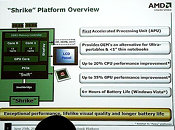
First AMD Fusion Specifications, Hint Toward RV710 Specs.
AMD Fusion could well be the first CPU to feature a graphics processor core. It will incorporate a graphics processor with specifications identical to the RV710. This CPU would be based on the 45 nm silicon fabrication process, and this processor will be manufactured at the Taiwan Semiconductor Manufacturing Company (TSMC). This GPU will be called "Kong". Here are its specifications:
- Core Frequency between 600 ~ 800 MHz
- 128-bit wide memory bus (DDR3, Side-port supportive)
- 40 Stream Processors
- 8 TMUs, 4 ROPs
- DirectX 10.1 support
- UVD
